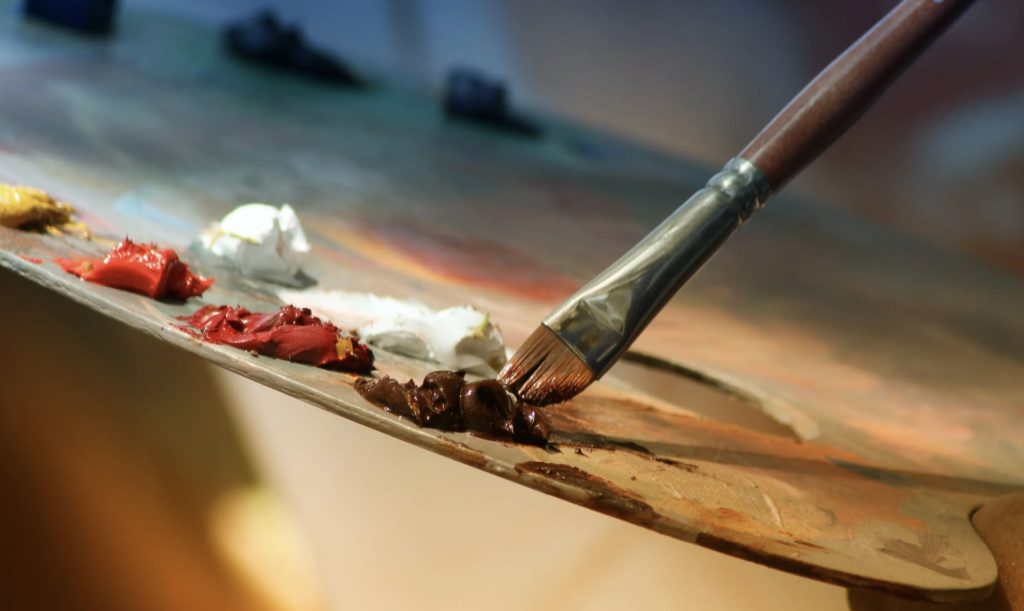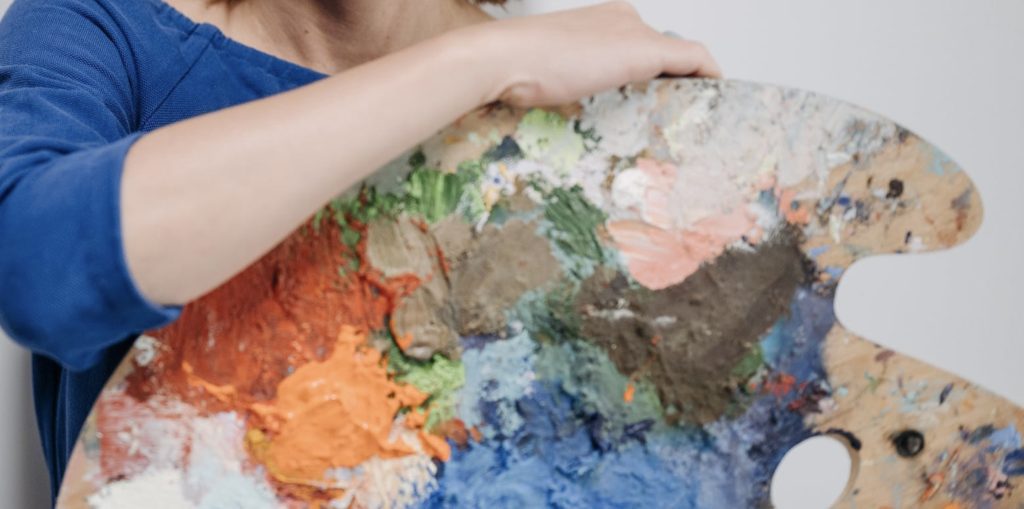With the right materials and a little bit of practice, you can create stunning works of art that you’ll be proud to display. I’ll cover the oil painting materials for beginners that you’ll need to get started on to create your first masterpiece. So, let’s get started!
Oil painting is a wonderful and rewarding art form that has been used for centuries by artists. It’s a versatile medium and it’s particularly well-suited for creating rich, vibrant colors and dramatic contrasts. If you’re new to oil painting, it can seem intimidating at first.
Oil Paint
As a beginner, it’s best to start with student-grade oil paints. They are more affordable and easier to work with than professional-grade oil paints. Student-grade oil paints are also often labeled as “studio” or “academic” quality.
These paints are made with less pigment and more binder than professional-grade paints. This makes them more forgiving and easier to manipulate.
When choosing oil paints
When choosing oil paints, look for a basic set that includes a range of colors, such as Cadmium Red, Cadmium Yellow, Ultramarine Blue, Titanium White, Burnt Sienna, and Raw Umber. These colors will allow you to create a wide range of hues and shades.
You can also consider using water-soluble oil paints as a beginner. These paints can be thinned and cleaned up with water, which makes them less toxic and easier to work with than traditional oil paints. However, they still produce the same beautiful results as traditional oil paints.
They can also help you to adjust into oil paint without having to purchase all of the extra necessities. Especially, if youre not sure oil paint is for you in the first place! Winsor and Newton oil paints have many options, including water soluble.
Ultimately, the type of oil paint you choose will depend on your personal preferences and budget. Remember to start with a basic set of colors and experiment with different techniques to find your own style and approach to oil painting.

Brushes
When selecting brushes, look for ones with soft bristles made of natural hair, such as hog or sable hair. Natural hair brushes are more absorbent and hold more paint, which allows you to apply paint more smoothly and evenly.
Natural hair brushes will also help to avoid chemical melting. With thin plastics (like cheap crayola brushes) distilled turpentine will melt down the plastic of the brush!
As you are gaining more experience, you will expand your brush collection to include more specialized brushes for specific effects. However, starting with a few basic brushes is a good way to get started in oil painting.
Solvents for your brushes, and artwork
Oil painting differs from water based paints because they require extra care for cleaning brushes.
Solvents are used in oil painting to thin paint, clean brushes, and create different effects. As a beginner in oil painting, it’s important to be aware of the different solvents available and how to use them safely. Brush cleaners can double as paint thinners for the canvas. However, paint thinners that are not marketed as brush cleaners do not properly clean your brushes.
Here are some common solvents used in oil painting:
- Mineral Spirits: Mineral spirits are a popular solvent used in oil painting. They’re odorless and less toxic than other solvents, making them a good choice for beginners. Mineral spirits are used to thin paint, clean brushes, and dissolve dried paint from brushes and palettes.
- Turpentine: Turpentine is a traditional solvent that has been used for centuries in oil painting. It’s a strong solvent that can be used to thin paint and clean brushes, but it has a strong odor and can be toxic, so it should be used with caution.
- Odorless Solvents: Odorless solvents are a newer type of solvent that are less toxic and have a lower odor than mineral spirits or turpentine. They’re a good alternative for artists who are sensitive to the fumes of other solvents.
- Linseed Oil: Linseed oil is a medium that can be mixed with oil paints to make them more fluid and glossy. It’s not a solvent in the traditional sense, but it can be used to create different effects in oil painting. Linseed oil does not clean your brushes. It is more for the thinning of your paint.
- Galkyd: Galkyd is designed to be mixed with oil paints to increase their transparency, glossiness, and drying time. It is great for enhancing or changing the medium without compromising the vibrancy of the oil colors. It also helps to smooth out brushstrokes and create a more even finish.
When using solvents, it’s important to work in a well-ventilated area and follow safety precautions. Avoid inhaling the fumes and wear gloves to protect your skin. Always read the label and follow the manufacturer’s instructions for use and disposal.
As a beginner, start with a small amount of solvent and add more as needed to achieve the desired effect.

Palettes
A palette is an essential tool in oil painting, used to mix and hold paint while you work. There are several types of palettes available, each with their own advantages and disadvantages.
Here are some common types of palettes used in oil painting for beginners:
- Wooden Palettes: Wooden palettes are a traditional choice for oil painting. They’re durable and provide a stable surface for mixing paint. Wooden palettes are also easy to clean, and the wood grain can help to keep the paint from sliding around too much.
- Glass Palettes: Glass palettes are smooth and easy to clean, making them a popular choice for many artists. They’re also great for color mixing because you can see the true color of the paint without any distortion.
- Disposable Palettes: Disposable palettes are made of a non-porous material, such as wax-coated paper or plastic. They’re convenient because you can simply discard them after use, and they’re also good for artists who like to work with a clean palette for each painting.
- Palette Pads: Palette pads are similar to disposable palettes, but they’re bound together like a notepad. They’re a good choice for artists who want a portable option or who like to work with a fresh palette for each painting.
- Plastic Palettes: Plastic palettes are most commonly found in art chains such as Michaels. They are a very cheap alternative, and also quite easy to clean. Im familiar with them, and think they are the worst option for oil painting.
When choosing a palette, consider the size and shape that will work best for you. A larger palette will allow you to mix more paint, but it may be more difficult to handle. A smaller palette may be more manageable, but you’ll need to mix paint more frequently.
Ultimately, the type of palette you choose will depend on your personal preferences and budget. I personally use

Canvases
As a beginner in oil painting, it’s important to choose a surface that will work well with your painting style and provide good adhesion for the paint.
Here are some common surfaces used in oil painting for beginners:
- Canvas: Canvas is a popular surface for oil painting. It’s available in a range of textures and sizes, and it provides a sturdy surface that can hold the weight of the paint. Canvas can be stretched over a wooden frame or purchased pre-stretched and mounted on a board.
- Paper: Paper is a lightweight and inexpensive surface that’s a good choice for sketching and practicing techniques. However, it’s important to choose paper that’s specifically designed for oil painting, as regular paper may not be strong enough to handle the weight of the paint.
- Wood: Wood panels provide a smooth and durable surface for oil painting. They can be sanded to create a variety of textures and are available in a range of sizes and shapes. However, it’s important to properly prepare the surface by priming it with gesso to ensure good adhesion for the paint.
- Masonite: Masonite is a type of hardboard that’s often used as a surface for oil painting. It’s smooth, durable, and less prone to warping than some other surfaces. Masonite can also be primed with gesso for better adhesion.
When choosing a surface, consider the texture and absorbency that will work best for your painting style. A smoother surface will provide sharper lines and details, while a more textured surface will add depth and interest to the painting. Ultimately, the choice of surface will depend on your personal preferences and the type of painting you want to create.
These are all the necessity oil painting materials for beginners.

